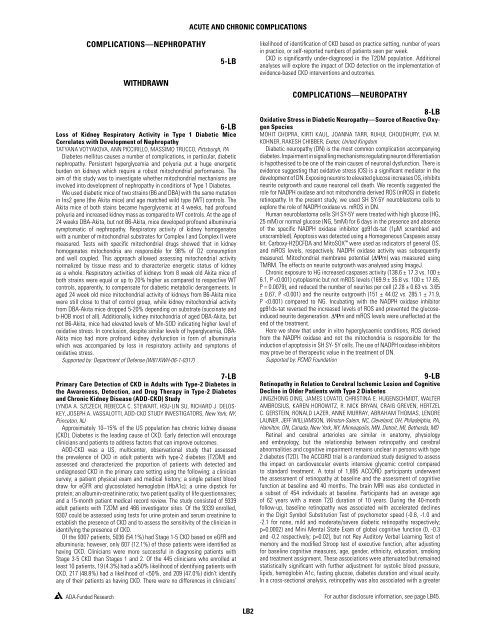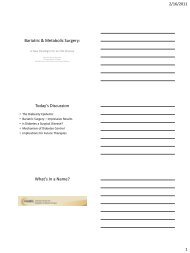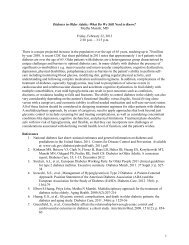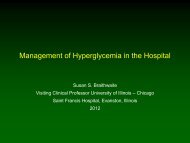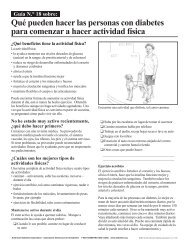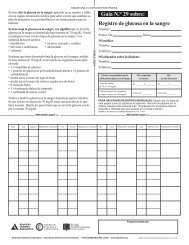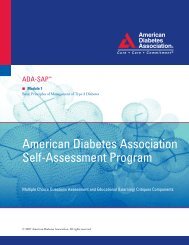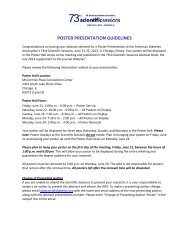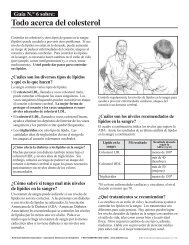A JournAl of the AmericAn DiAbetes AssociAtion
A JournAl of the AmericAn DiAbetes AssociAtion
A JournAl of the AmericAn DiAbetes AssociAtion
- No tags were found...
You also want an ePaper? Increase the reach of your titles
YUMPU automatically turns print PDFs into web optimized ePapers that Google loves.
Acute and Chronic ComplicationsComplications—NephropathyWithdrawn5-LBlikelihood <strong>of</strong> identification <strong>of</strong> CKD based on practice setting, number <strong>of</strong> yearsin practice, or self-reported numbers <strong>of</strong> patients seen per week.CKD is significantly under-diagnosed in <strong>the</strong> T2DM population. Additionalanalyses will explore <strong>the</strong> impact <strong>of</strong> CKD detection on <strong>the</strong> implementation <strong>of</strong>evidence-based CKD interventions and outcomes.Complications—Neuropathy6-LBLoss <strong>of</strong> Kidney Respiratory Activity in Type 1 Diabetic MiceCorrelates with Development <strong>of</strong> NephropathyTATYANA VOTYAKOVA, ANN PICCIRILLO, MASSIMO TRUCCO, Pittsburgh, PADiabetes mellitus causes a number <strong>of</strong> complications, in particular, diabeticnephropathy. Persistent hyperglycemia and polyuria put a huge energeticburden on kidneys which require a robust mitochondrial performance. Theaim <strong>of</strong> this study was to investigate whe<strong>the</strong>r mitochondrial mechanisms areinvolved into development <strong>of</strong> nephropathy in conditions <strong>of</strong> Type 1 Diabetes.We used diabetic mice <strong>of</strong> two strains (B6 and DBA) with <strong>the</strong> same mutationin Ins2 gene (<strong>the</strong> Akita mice) and age matched wild type (WT) controls. TheAkita mice <strong>of</strong> both stains became hyperglycemic at 4 weeks, had pr<strong>of</strong>oundpolyuria and increased kidney mass as compared to WT controls. At <strong>the</strong> age <strong>of</strong>24 weeks DBA-Akita, but not B6-Akita, mice developed pr<strong>of</strong>ound albuminuriasymptomatic <strong>of</strong> nephropathy. Respiratory activity <strong>of</strong> kidney homogenateswith a number <strong>of</strong> mitochondrial substrates for Complex I and Complex II weremeasured. Tests with specific mitochondrial drugs showed that in kidneyhomogenates mitochondria are responsible for 98% <strong>of</strong> O2 consumptionand well coupled. This approach allowed assessing mitochondrial activitynormalized by tissue mass and to characterize energetic status <strong>of</strong> kidneyas a whole. Respiratory activities <strong>of</strong> kidneys from 8 week old Akita mice <strong>of</strong>both strains were equal or up to 20% higher as compared to respective WTcontrols, apparently, to compensate for diabetic metabolic derangements. Inaged 24 week old mice mitochondrial activity <strong>of</strong> kidneys from B6-Akita micewere still close to that <strong>of</strong> control group, while kidney mitochondrial activityfrom DBA-Akita mice dropped 5-20% depending on substrate (succinate andb-HOB most <strong>of</strong> all). Additionally, kidney mitochondria <strong>of</strong> aged DBA-Akita, butnot B6-Akita, mice had elevated levels <strong>of</strong> Mn-SOD indicating higher level <strong>of</strong>oxidative stress. In conclusion, despite similar levels <strong>of</strong> hyperglycemia, DBA-Akita mice had more pr<strong>of</strong>ound kidney dysfunction in form <strong>of</strong> albuminuriawhich was accompanied by loss in respiratory activity and symptoms <strong>of</strong>oxidative stress.Supported by: Department <strong>of</strong> Defense (W81XWH-06-1-0317)7-LBPrimary Care Detection <strong>of</strong> CKD in Adults with Type-2 Diabetes in<strong>the</strong> Awareness, Detection, and Drug Therapy in Type-2 Diabetesand Chronic Kidney Disease (ADD-CKD) StudyLYNDA A. SZCZECH, REBECCA C. STEWART, HSU-LIN SU, RICHARD J. DELOS-KEY, JOSEPH A. VASSALOTTI, ADD-CKD STUDY INVESTIGATORS, New York, NY,Princeton, NJApproximately 10–15% <strong>of</strong> <strong>the</strong> US population has chronic kidney disease(CKD). Diabetes is <strong>the</strong> leading cause <strong>of</strong> CKD. Early detection will encourageclinicians and patients to address factors that can improve outcomes.ADD-CKD was a US, multicenter, observational study that assessed<strong>the</strong> prevalence <strong>of</strong> CKD in adult patients with type-2 diabetes (T2DM) andassessed and characterized <strong>the</strong> proportion <strong>of</strong> patients with detected andundiagnosed CKD in <strong>the</strong> primary care setting using <strong>the</strong> following: a cliniciansurvey; a patient physical exam and medical history; a single patient blooddraw for eGFR and glycosolated hemoglobin (HbA1c); a urine dipstick forprotein; an albumin-creatinine ratio; two patient quality <strong>of</strong> life questionnaires;and a 15-month patient medical record review. The study consisted <strong>of</strong> 9339adult patients with T2DM and 466 investigator sites. Of <strong>the</strong> 9339 enrolled,9307 could be assessed using tests for urine protein and serum creatinine toestablish <strong>the</strong> presence <strong>of</strong> CKD and to assess <strong>the</strong> sensitivity <strong>of</strong> <strong>the</strong> clinician inidentifying <strong>the</strong> presence <strong>of</strong> CKD.Of <strong>the</strong> 9307 patients, 5036 (54.1%) had Stage 1-5 CKD based on eGFR andalbuminuria; however, only 607 (12.1%) <strong>of</strong> those patients were identified ashaving CKD. Clinicians were more successful in diagnosing patients withStage 3-5 CKD than Stages 1 and 2. Of <strong>the</strong> 445 clinicians who enrolled atleast 10 patients, 19 (4.3%) had a ≥50% likelihood <strong>of</strong> identifying patients withCKD, 217 (48.8%) had a likelihood <strong>of</strong>


